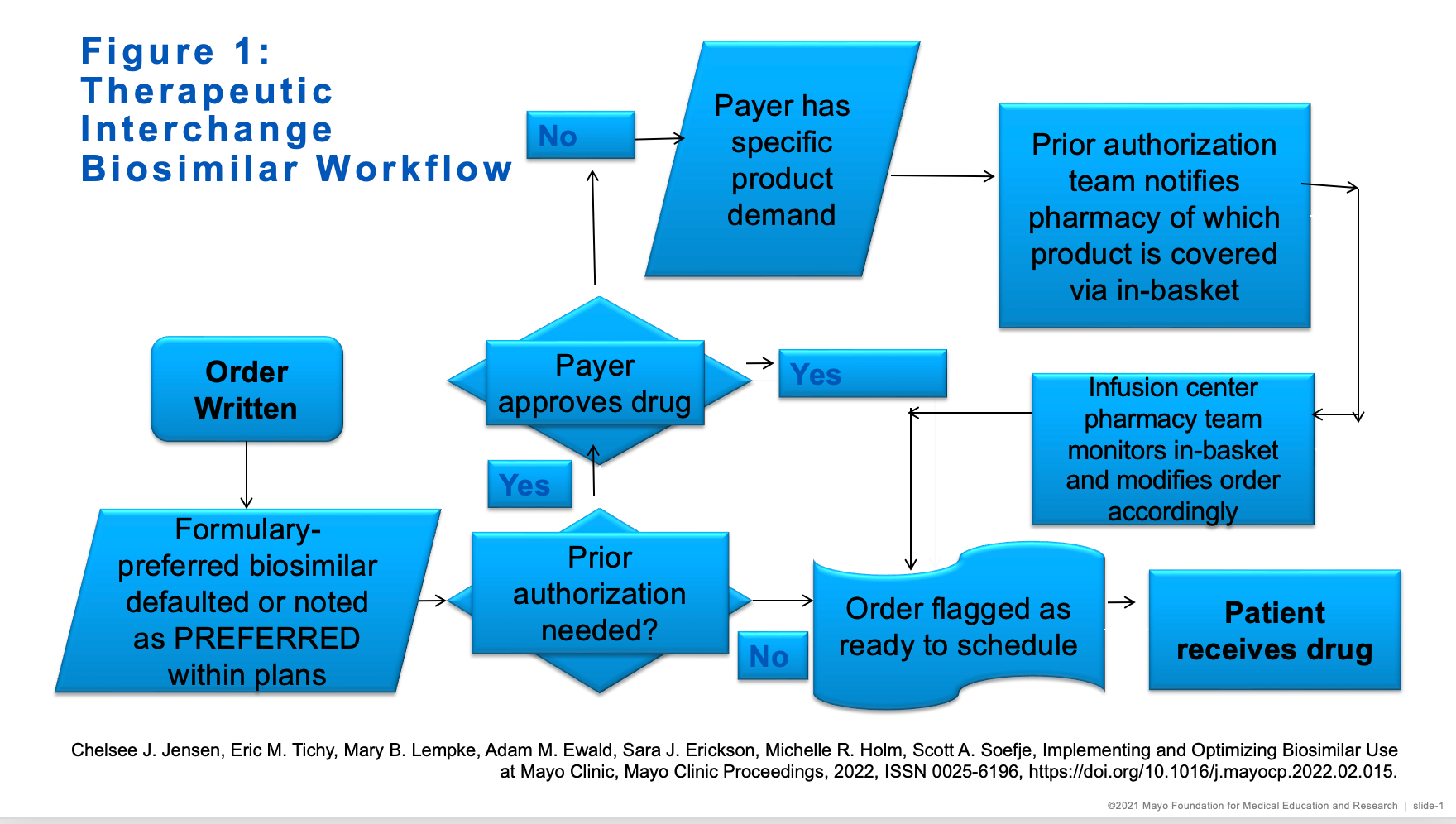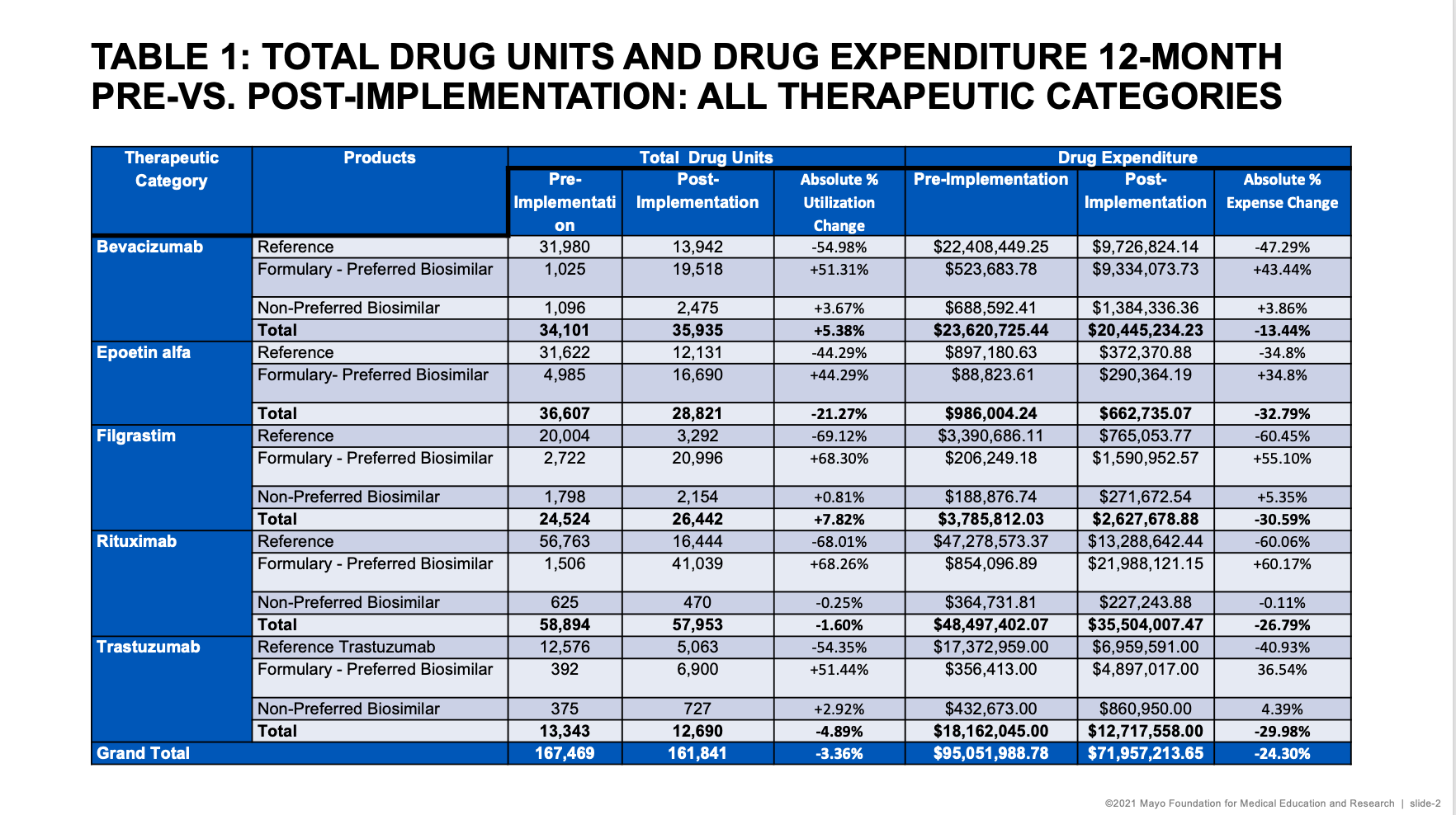Article
Multidisciplinary Approach is Critical for Biosimilar Implementation, Optimization
Author(s):
Health systems must have a flexible workflow in place to allow the use of non-preferred agents to accommodate payer demands and reduce financial toxicity.
Biosimilar competition in the US market has led to significant health care expenditure reduction. Biosimilars are assigned unique Healthcare Common Procedure Coding System (HCPCS) codes by the Centers for Medicare and Medicaid Services (CMS) and there are few AB-rated interchangeable products currently on the market.
These factors create logistical hurdles with how to successfully integrate biosimilars into a health system practice.
Furthermore, due to varying payer coverage and demands, health systems must have a flexible workflow in place to allow the use of non-preferred agents to accommodate payer demands and reduce financial toxicity to the health care system and patients.
Methods
Multidisciplinary Team Formation and Stakeholder Buy-In
Creating and maintaining a multidisciplinary team who understands the biosimilar strategy and is vested for project success is instrumental. At Mayo Clinic, our multidisciplinary group for biosimilar implementation includes supply chain management pharmaceutical contracting and formulary, revenue cycle prior authorization (PA), pharmacy operations, pharmacy informatics, and leadership from practice, pharmacy, and nursing.
Our biosimilar implementation project focused on 5 biologic categories, including bevacizumab (Avastin), epoetin alfa (Epogen, Procrit), filgrastim (Neupogen), rituximab (Rituxan), and trastuzumab (Herceptin). First, we educated providers on the FDA Biosimilar Regulatory Approval Pathway and gained consensus that biosimilars were equally safe and effective as reference products.
Second, we outlined the financial implications with emphasis on health care expenditure reduction, CMS reimbursement of biosimilars, and financial advantages for 340B sites. Third, we elicited feedback from PA teams to understand what our major commercial payers were demanding.
Our PA team confirmed that many commercial payers required use of biosimilars but were not mandating a specific biosimilar to be used. The multidisciplinary team, with agreement from key stakeholders, agreed on a biosimilar-first strategy with a collective goal to reduce the overall cost of care for classes of drugs with biosimilar competition.
We then leveraged the agreement of equivalent safety and efficacy between biosimilars and reference products along with understanding that our major commercial payers were mandating biosimilars—but not specific ones—to complete a completive bid across all 5 biologic categories with emphasis on the lowest net cost product and favorable contracting terms.
Once contracting was completed, we selected formulary preferred biosimilars in each pharmaceutical category. Aligning with our goal to reduce the overall cost of health care and putting the needs the patient first, purchase discount contracts were used from which savings were passed onto payers and patients.
Operationalization
Our next step was to determine how to operationalize use of biosimilars and develop a flexible workflow to substitute biosimilars. Because there were no FDA-approved interchangeable biosimilars in the 5 biologic categories we targeted, we checked the state board of pharmacy rules for each state in which the Mayo Clinic operates and decided that therapeutic substitution would be a suitable strategy for effective biosimilar implementation.
We then established a workflow between pharmacy and PA teams to facilitate biosimilar therapeutic interchange while accommodating payer demands (Figure 1).

Working with pharmacy informatics colleagues, we optimized EHR ordering pathways. Within the hematology-oncology ordering pathway, we had the ability to default our formulary-preferred biosimilars and used advanced order panels to access non-preferred biosimilars and reference products.
The ability to default accelerated biosimilar use within the hematology and oncology settings and reduced workload burden. Within hospital outpatient infusion and inpatient ordering pathways, we did not have the ability to default formulary-preferred biosimilars, thus we sequenced preferred agents first with notation of “Preferred” and non-preferred agents subsequently with notation of “Restricted.”
Regardless of the ordering pathway, the ability to change to an alternative, non-preferred product leveraging the pharmacist-driven therapeutic interchange was pertinent to accommodate payer demand and reduce financial risks to health care institutions and patients. Once implementation was planned, providers were asked to initiate new patients on biosimilars.
For current patients on a biologic reference product, they were asked to consider changing those patients to a biosimilar upon PA renewal.
Monitoring Success
We tracked drug units and pharmaceutical spend for refence and biosimilars in each therapeutic category at baseline prior to EHR implementation and in 3-month intervals post EHR implementation using purchase history information from our primary wholesale distributor. For the trastuzumab category, we had to use a conversion factor as reference trastuzumab is supplied in 150 mg single dose vials and biosimilars are supplied as 150 mg single-dose or 420 mg multi-dose vials.
When concerns arose, we leveraged reporting tools within the EHR to determine root causes. We then made additional EHR optimization changes, communicated directly to specific practices for proactive order conversion, and leveraged frontline pharmacy staff to optimize conversion, particularly for 340B practice sites.
Results
Comparing the baseline quarterly average market share compared to the final post-implementation measurement period, the absolute percentage increase of formulary-preferred biosimilar use was 69% for bevacizumab, 63% for epoetin alfa, 80% for filgrastim, 79% for rituximab, and 72% for trastuzumab.
Corresponding expense reduction in each category comparing baseline to 12-month post-implementation was $3.175 million for bevacizumab, $323,269 for epoetin alfa, $1.158 million for filgrastim, $12.993 million for rituximab, and $5.444 million for trastuzumab (Table 1).

In the 12 months after the biosimilar-first strategy was implemented at Mayo Clinic, there was a $23.1 million dollar pharmaceutical line item savings realized, amounting to a 24.3% expense reduction.
Conclusion
The creation of a multidisciplinary group, EHR optimization, and flexible workflow using a pharmacist-driven therapeutic interchange is an effective strategy to accelerate biosimilar use within a health care institution and achieve significant pharmaceutical line item savings.
Reference
Jensen Chelsee J, Tichy Eric M, Lempke Mary B, Ewald Adam M, Erickson Sara J, Holm Michelle R, Soefje Scott A.Implementing and Optimizing Biosimilar Use at Mayo Clinic. Mayo Clinic Proceedings, 2022, ISSN 0025-6196, https://doi.org/10.1016/j.mayocp.2022.02.015
Newsletter
Stay informed on drug updates, treatment guidelines, and pharmacy practice trends—subscribe to Pharmacy Times for weekly clinical insights.






